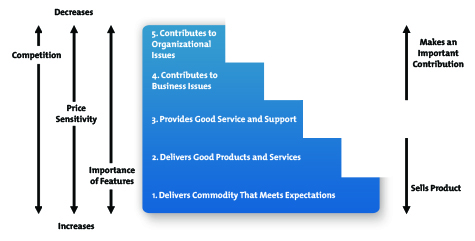The Buy-Sell Hierarchy
Understanding Customer Relationships

© iStockphoto
BirdImages
What distinguishes you from your competitors?
Whatever your industry, you want your customers to look to you – and not your competitors – to meet their needs.
For this to happen, you first need to think about the relationships that you have with your customers. For example, do they see you as one of many potential suppliers, or as a business partner who they rely on to solve strategic issues? Do you listen to their needs and work hard to meet them, or do you just offer them products that meet a basic specification?
In this article, we'll look at the Buy-Sell Hierarchy. This model helps you explore the relationships that you have with your customers, and, in particular, think about how closely you work with them. We'll then look at how you can use the model to build more strategic relationships.
About the Tool
Consultants Robert Miller and Stephen Heiman developed the Buy-Sell Hierarchy, and explained it in their 2005 book, "The New Successful Large Account Management."
The Buy-Sell Hierarchy, shown in figure 1, below, features five levels that represent an increasingly strategic collaboration between yourself and your customers.
Figure 1 – The Buy-Sell Hierarchy

From "The New Successful Large Account Management" by R. Miller and S. Heiman. Published by Kogan Page, 2006. Reproduced with permission.
At level 1, there's no collaboration between your organization and your customers. You provide a product or service that meets customers' basic specifications, but you may be one of many suppliers. Customers may shop around to get better support and service, and to meet more strategic needs.
You can move up the hierarchy by understanding more about your customers' needs, and by doing more to meet them than your competitors do. For example, at level 2, you provide higher quality products and services. At level 3, your products and your services outperform others in the market.
By level 5, you and your customers are strategic partners: you understand their long-term needs, and you work together to meet them. Most importantly, your customers recognize that you're a key partner, and that you're indispensable to their growth. Clearly, this is a great place to be!
The Five Levels
Miller and Heiman point out that it's your customers who ultimately decide which level your organization has reached in the hierarchy. However, you can still make your own assessment of your customer relationships.
Below, we outline the characteristics of each level of the hierarchy. Use these to think about your customer relationships, and then apply the approaches identified to move to higher levels...
Access the Full Article
This article is only available in full within the Mind Tools Club.
Learn More and Join TodayAlready a Club member? Log in to finish this article.


